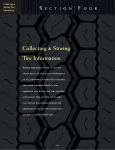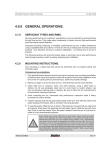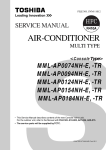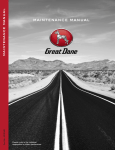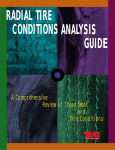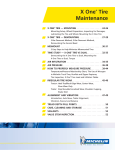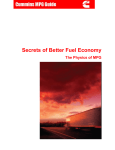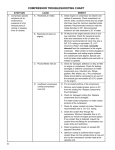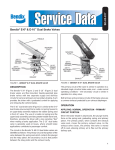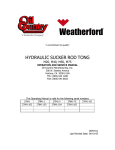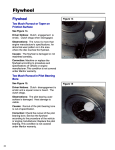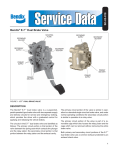Download Factors Affecting Treadwear
Transcript
Factors Affecting Treadwear S E C T I O N Factors Affecting Treadwear Alignment problems are often blamed for all irregular treadwear. However, many other factors can be responsible for, or contribute to, irregular wear. While the wear pattern can often suggest the cause of the problem, it sometimes takes real detective work to track down and correct the real source of trouble. 50 S E V E N S E C T I O N S Factors Affecting Treadwear E V E N Footprint Shapes ALIGNMENT DUAL MATCHING INFLATION Bias Radial Figure 7.1 A bias tire footprint is oval shaped… the radial footprint is rectangular. BALANCING TIRE SELECTION The issue of irregular tire wear has always been a concern even in the days when most trucks ran bias ply tires. With today’s longer wearing radial tires, irregular wear has surfaced as the primary concern of most truck maintenance managers. In fact, it is the ability of today’s advanced radial tires to deliver long original tread life which requires even more attention to good maintenance practices and vehicle alignment. Radial tires have a different footprint shape than bias tires. See Figure 7.1. This results in less scrubbing and longer tread life. However, this same attribute of the radial design can also result in the tire exhibiting more irregular wear when vehicle and tire maintenance are below par. These wear patterns are not as evident in bias ply tires. Since the tread wears away usually much faster on bias tires, unusual wear patterns are literally scrubbed off as they develop. The Technology & Maintenance Council (TMC) of the American Trucking Association has publicly said that the positive attributes of the radial tire, particularly longer tread life, can result in the tire exhibiting more irregular wear patterns when vehicle and tire maintenance or tire construction is inadequate. The TMC has also published an excellent reference guide titled Radial Tire Conditions Analysis Guide. This booklet clearly defines the types of irregular wear common to steer, drive, and trailer axles and offers possible reasons that such wear occurs. Figure 7.2. Contact The Technolgy & Maintenance Council at http://tmc. truckline.com or order publications through The ATA Marketplace: 1-800-282-5463. 51 Figure 7.2 Radial Tire Conditions Analysis Guide — an excellent reference book. Factors Affecting Treadwear S E C T I O N S E V E N STEER TIRE WEAR Uneven or irregular tire wear is a widespread problem in today’s trucking industry. All brands of rib tires have experienced this undesirable situation. Extensive testing has proven that vehicles with lightly loaded front axles are more prone to irregular steer tire wear than those with heavily loaded front ends Figure 7.3. By lightly loaded, we’re talking about a front axle configuration of 10,000 to 10,500 pounds or less for the typical linehaul-sized tires. We also know that tractors with wheelbases more than 200 to 210 inches long are also candidates for irregular steer tire wear. Several factors help determine steer tire load. These include vehicle configuration, wheelbase, axle set-back and fifth wheel position. How this load contacts the road surface is then influenced by alignment settings. Vehicle toe, camber, caster, drive axle parallelism and perpendicularity are important factors in steer tire wear patterns. All things considered, how a tire tread wears depends on the forces that act upon the contact patch of that tire as it meets the road. If a tire is highly loaded, it tends to have a square footprint shape. The shoulder rib contact area is very long, about the same length as the center ribs. As the tire rotates, contact with the road is good. By contrast, a lightly loaded tire tends to have very short shoulder ribs, much shorter than the center rib. As this tire rotates, the footprint center maintains very good contact but the shoulder area does not. This causes much more scrubbing action and wearing away of the shoulder rib. Vehicle misalignment, non-parallel or non-perpendicular drive axles and suspension system problems naturally affect steer tire wear. While many fleet owners and maintenance personnel believe they have heavily loaded steer axle applications, they’re running with loads in the 10,000 to 10,500 pound range and below. Heavy GVW doesn’t equate with heavy front axle load. Load/Footprint Comparison KEY IRREGULAR WEAR CONDITIONS DEFINED Chamfer wear — A nibbling or erosion that occurs on the outside edge of the shoulder ribs of a tire. This condition typically results from slow rate of wear line-haul service and does not indicate a tire or vehicle problem. Erosion or river wear — A nibbling effect at the edge of the interior ribs of a tread design. It’s most often seen on very slow wearing tires in line-haul steer applications. Figure 7.3 Tire inflation also plays a role in tire wear. Once loading is determined, you must run your tires at the proper inflation to match loading. Your tire company representative should help you determine optimum inflation for that configuration. A good rule of thumb — inflate to the T & RA recommended pressure required for the load plus 10 psi. This will compensate for tire-to-tire variations and normal leakage. Periodic inspections of your vehicle and tires are a must. Look for signs of irregular wear or vehicle component problems. Then take immediate action to correct these problems. And finally, work very closely with your tire company representative to determine the right tire for the application. A tire designed for highway use, for example, may not be the best choice for running off-road. Tires, like trucks, are built to do specific jobs. Defining that mission is a good first step. 52 Fast rib wear — One or more of the interior ribs of a tire wear away much more rapidly than the adjacent ribs. Tire construction, itself, may be the cause. Diagonal wear — Rapid wearing away of a diagonal patch of the tread design. Causes are generally non-tire related. Probable suspects include mismounting a tire on the wheel, brake or bearing problems. Diagonal tire wear is not caused by a heavy splice or component ending in a tire. Fast shoulder wear — Rapid wearing away of one or both tire shoulders on steer axle position. The problem shows up as smooth rapid wear or a scalloped “island wear” configuration as the tire runs. S E C T I O N S E V E N Factors Affecting Treadwear SETBACK STEER AXLES Though increasingly popular today, “setback” steer axles are not new to the trucking industry. For many years, “setback” front axles have been used in on/off road applications in construction, oil field, waste hauling and specialized services. The primary benefits of “setback” steer axles are improved maneuverability, more desirable load distribution and, in many cases, improved ride. The application of “setbacks” to over-the-road linehaul type trucks, however, is fairly recent. The term “setback” is relative, and some designs are more setback than others. Generally, the axle of a modern “setback” linehaul tractor is positioned about 13 to 15 inches behind its traditional position. This design is typically found on long conventional and medium conventional cab models. More pronounced “super setbacks” are usually found on COE models where the axle is positioned about 25 inches behind its normal position. Collectively, all trucks with “setback” axles can be expected to present distinct characteristics which can affect tire selection and usage patterns. These include shorter wheelbases, higher steer tire loads, higher wheel cut angles. While these characteristics are “setback” steer axle benefits, there are others that can adversely affect tire wear. Steer tire inflation pressures As a general rule, irregular wear tendencies are more of a problem on trucks with lightly loaded steer axles. This is especially true of trucks pulling heavy loads where high drawbar force on the kingpin tends to unload the steer axle when the truck is rolling. Rearward positioned fifth wheels offer further opportunities to reduce steer axle loads. “Setback” axle trucks tend to have heavier steer tire loading both statically and dynamically. This is because most of them also employ extensive aerodynamic packages that restrict fifth wheel placement flexibility. In fact, some “super setback” designs can have nearly identical steer tire loadings from bobtail to fully loaded condition. Tires on the “super setbacks” must work harder, and in some cases, require higher inflation pressures to support the increased loads. Load/inflation pressure tables are available from www.goodyear.com/truck, Engineering Data Book or Over-the-Road Truck Tires, or a qualified tire company representative. If higher steer tire pressures are required, this may mean you’ll be using different inflation pressures for drive and trail tires. Increased lateral tire scrub As the wheelbase dimension shortens, steer tires must generate an increasing amount of side force to turn the truck chassis when cornering. This is especially true for tandem drive axle units. As an example, compare a tractor with a 140-inch wheelbase with one whose wheelbase is 230 inches Figure 7.4. Steer tires on the shorter vehicle must generate 65 percent more cornering force to slide the tandems around a Truck Wheelbase Effects on Steer Tire Wear 230 140 Shorter wheelbase truck must develop more cornering force with steer tires to generate the same cornering moment to turn truck or to counteract a chassis thrust angle Figure 7.4 corner. The normal result will be faster overall steer tire wear rates than experienced by the longer wheelbase unit. Another result will be less irregular wear because the extra scrubbing tends to clean up uneven wear patterns as they develop. You’ll also find tires with wider treads or more massive tread rib designs will usually perform better on the shorter wheelbase vehicles. 53 Loaded vs. unloaded alignment angles Differences in payload can also affect steer tire loading differently, depending on fifth wheel location, suspension type and degree of axle setback. Therefore, you can’t continue to assume traditional changes in toe, camber and caster from bobtail condition (typical when checking alignment) to fully loaded. In fact, certain “setback” axle designs have shown no camber change. Toe change, on the other hand, can range from no change to a decrease, or, in some cases, to an increase with additional load. Caster change may also be different from model to model, since most “setback” axle designs also employ springs that are longer or have different deflection characteristics. Ackermann steering geometry While Ackermann geometry has not typically been a major problem on linehaul type vehicles, it should now be considered because most “setback” axle designs also incorporate increased wheel cut angles. The industry standard for many years has been in the 32- to 34-degree range. Now typically in new designs are wheel cuts of 42 to 44 degrees, meaning steer tires are likely to be scrubbed more severely when turning. As a result, the effects of improper or compromised Ackermann geometry will be more pronounced. Suspension damping control Damping control has also become more important, since many “setback” axle designs employ softer riding suspensions. The older stacked spring designs had considerable leaf-to-leaf friction, which tended to act as a built-in shock absorber. This damping also varied with loading. Now, depending on the specific suspension, damping control can become critical. Shock absorbers should be properly sized, maintained and replaced when necessary to control suspension movement, which, in turn, leads to tire wear irregularities. Factors Affecting Treadwear S E C T I O N S E V E N DRIVE TIRES Let’s review some of the key elements that impact drive tire wear: Engine Torque (More usable torque means less tread life) Engine torque is measured in footpounds of twisting force without regard to time. Peak torque on many of today’s engines occurs at lower engine rpms and remains at a relatively high level over a wide rpm range. A typical engine might develop 1,200 to 1,250 foot-pounds of peak torque at only 1,300 rpms. High engine torque over a wide rpm range adversely affects drive tires, which transmit this higher torque to the highway. Increased stress, deflection, deformation and reduced tread life result. Highway Speeds (Faster speeds mean less tread life) Linehaul tractor trailers are now permitted to travel at 65 mph in rural areas in place of 55 mph in 71 percent of the states. At 65 mph, that means a 16-percent tread life penalty, according to one study. Experts cite as causes increased tire footprint deformation and higher tire running temperatures. Inexperienced Drivers (Tread life can suffer) High turnover means truckload and irregular route drivers are less experienced than in the past. Driver turnover surpasses 100 percent annually in some fleets. Inexperienced drivers can abuse their vehicles with rough gear shifting, spinning wheels on wet surfaces and fast accelerating and braking. Setback Steer Axles (Affect drive tire wear) Setback steer axles were engineered to improve vehicle comfort, load distribution and vehicle maneuverability. A tractor’s wheelbase is shorter when its steer axle is placed 13 to 15 inches behind the usual position (or up to 25 inches in the case of super setback axles). Shorter wheelbases mean greater wheel cut angles, from the normal 30 degrees up to 42 inches in some cases. Smaller turning radii are the result of higher cut angles. But tighter turns equate to higher cornering forces in the drive tire footprint and reduced tread life. Depending on the percentage of straight-ahead highway driving, these forces can also cause rear tandems to wear much faster than forward tandems. Rear Suspensions (Service/maintenance sensitive) Good suspension and shock maintenance is critical to obtain long tread life and uniform wear. Inadequate care can cause uncontrolled jounce and rebound, and over long time periods, irregular drive tire wear as well. Empty backhauls can aggravate the problem. Lightly loaded trucks with leaf spring suspensions and deep tread tires can develop a cyclic bouncing process, particularly on rutted or deteriorating highways and highly crowned roads. Significant tread life losses and various degrees of irregular wear can result. 54 Extreme variations in air pressures of dual wheel assemblies is another major cause of reduced tread life and also of irregular drive tire treadwear. Fleets that don’t control air pressures of duals in effect allow the tire with lower air pressure to overdeflect, deform, scrub excessively and non-uniformly and eventually develop irregular drive tire wear. Here are some tips to obtaining desirable drive tire tread life with minimum irregular wear: • Recognize the effect of vehicles, service and operating conditions on drive tire tread life. • Train drivers in proper operating techniques. • Exercise speed control. • Maintain rear axle/tandem alignment. • Balance air pressure between duals. S E C T I O N Suspension systems are changing. Early trucks were stiffly sprung with suspensions similar to horse-drawn buggies. Today, the demand is for a softer ride. Better driver and passenger comfort is one reason. Another is a need to protect delicate cargo such as electronic equipment and computers. For these and other reasons, air suspensions are becoming more popular. There are two basic suspension systems. A taper leaf is used primarily on steer axles and trailer axles. Air suspensions are used mainly on drive axles and trailer axles, but are now being introduced on steer axles. Besides a softer ride, air suspensions provide full suspension movement regardless of load condition and the ability to equalize the load between axles. Radial tires work best when in firm contact with the road surface. Suspension systems are a combination of springs and dampers (shock absorbers). Older, multiple-leaf spring suspensions had so much leaf-to-leaf friction that they were virtually self-damping Figure 7.5. Today’s taper-leaf systems, with fewer leaves and space between leaves, produce little selfdamping. In fact, a low friction material often is placed between the leaves to reduce damping. Air bags also lack self-damping. Placement of shocks in the suspension system can help or hinder their effectiveness. Consider, for example, shocks mounted near the center of the frame. Bump inputs to both the right and left sides of the axle – such as road expansion joints – are properly damped. But a bump input to one side or the other results in the axle rotating about its center. There is little shock compression or extension and little damping of axle movement. Fluid leaks around the shock’s piston rod are a sign that shocks should be replaced. Replace a shock absorber if one end is disconnected or if the shock can be easily compressed and extended. S E V E N Leaf Springs Stacked Multiple Leaves (Much Leaf to Leaf Friction) Taper Leaf (Little Leaf to Leaf Friction) Figure 7.5 Taper-Leaf springs produce little self-dampening. Temperature is another way to check shock effectiveness. After a truck returns from a highway run, a mechanic should touch the shock absorber. A warm shock is working, a cold shock is not. With air suspensions, shock absorbers are also considered the “stops” at the extended end of the suspension travel. Present and future trucks will have softer, more compliant suspensions that provide many advantages over older systems. Proper maintenance of these suspensions will assure the benefits of these systems are realized without a negative impact on tire life. Vehicles should be spec’d considering ride and tirewear. Frequent suspension system maintenance assures maximum treadwear and tire life. 55 Factors Affecting Treadwear SHOCK ABSORBERS — 3 CONSIDERATIONS • Selection. For maximum effectiveness, select the right shock absorber for the job. Consult with a manufacturer’s representative to make the proper choice. • Placement. Proper placement of shock absorbers in a suspension system ensures optimum shock compression or extension and axle movement damping. • Maintenance. Regularly check shock absorbers to make sure they are performing adequately. Replace shocks when they are worn. BEARING ADJUSTMENT Ask five different fleet maintenance managers about how wheel bearing adjustments affect alignment settings and you’re likely to get five different answers. They’ll likely agree that axle end play is a tire wear concern but the reasons why may not be fully understood. Axle end play is an indicator of wheel bearing adjustment. End play is the movement, in and out, of the tire/wheel/ hub assembly at the end of the axle. Most vehicle and axle manufacturers say .001-inch to .005-inch end play is acceptable. Trailer manufacturers may allow up to .020 inch. You need a dial indicator to measure this movement accurately, but experienced mechanics and technicians can grab the tire at two points 180 degrees apart and detect in-and-out movement by giving the assembly a wiggle. Not a precise measurement by any means, but experienced hands can usually tell if there is too much play, flagging the need for maintenance. Factors Affecting Treadwear S Axle end play changes camber and toe setting. For example, pushing in the top of the assembly and pulling out at the bottom will change camber angle. Similarly, pushing on the front side of the tire while pulling on the rear alters toe setting, which raises the obvious question: “How much change in camber and toe does wheel bearing end play cause?” The amount of change can be predicted with mathematical calculations. The graph in Figure 7.6 shows camber change for a given amount of end play. End Play vs. Camber End Play (in) .020 .015 .010 Max. Recommended By Most Manufacturers .005 0 .02 .04 .06 .08 .10 .12 Total Camber Change (˚) Figure 7.6 If end play and bearing taper angle are known, calculations may be used to determine the diametral clearance (DC) of both inner and outer bearings. Then, knowing the distance between the bearings, the angle change is found using the following formula: 1/2 DC (Inner Bearings) x 1/2 DC (Outer Bearing) Distance between bearings E C T I O N A .020-inch end play will only change the camber about 1/8 of a degree. Camber tolerance is commonly plus or minus 1/4 of a degree, so if end play is kept within spec, the camber change caused by this amount of play is insignificant. But tolerances are closer for toe. Toe setting is commonly expressed as the difference in distance from the tractor center line to the front and rear edge of each tire as measured at hub center height. Recommended settings for over-the-road trucks are: Steer axles: Toe in 1/16'' ± 1/32'' (unloaded) For trailer axles: 0 ± 1/32'' We also calculated possible toe-in change at various end play settings. Remember, toe in is the relationship between front and rear sides of one tire, so we can look at toe change due to end play on one side or both sides of the vehicle. The graph in Figure 7.7 illustrates our findings. End Play vs. Toe Change or Camber Change E V E N toe properly so irregular tire wear will be chronic if end play is not within spec. Some experienced mechanics claim improved tire and bearing life with “preloaded” bearings. In addition, some long-life, low maintenance wheel systems are being offered that require a preloaded bearing arrangement as part of their standard installation requirements. To avoid overtorquing these systems, a great deal of care must be used to achieve a proper bearing preload. As a result, the manufacturer’s recommendations should be closely followed. Bearing manufacturers strongly discourage overtorquing a bearing just to eliminate servicing after a break-in period. Although you get more bearing and tire wear, a too-loose bearing is safer on an over-the-road truck than a too-tight one: the overtorqued bearing can heat up, may crack and could cause a dangerous axle failure on the road. We urge you to limit axle end play to the low end of the specified tolerance range and follow the manufacturer’s recommendations when preload is required. Make periodic end play checks when permitted by the manufacturer to maintain tight settings. The payoff will be more accurate toe adjustment, safer operation and longer tire life, particularly for high mileage radials. ENVIRONMENTAL EFFECTS Figure 7.7 End Play vs. Toe Change or Camber Change S If both sides of the steer axle are at maximum allowable end play, toe change of .080 (more than 1/16) inch could result. That’s a very significant difference because maximum allowable toe tolerance is only 1/32-inch. So you should keep end play on steer axles well below accepted maximums to get longest tire life. Maintain within specs for longer tire wear. Obviously, any tire/wheel/ hub assemblies that are outside the current spec for axle end play have potential for tire wear problems. And they won’t go away. Excessive end play prevents setting 56 Road surfaces and environmental factors play a big factor in tire performance and tread life. An understanding of the effect pavement conditions have on treadwear can help fleet managers analyze variables in overall tire costs. Engineering studies have drawn conclusions about the following variables: Road surface textures on treadwear Tire engineers agree that rough, sharp surfaces and those with embedded shells are more abrasive and tend to generate faster wear rates than polished concrete and smooth asphalt. Rough surfaces create a higher scrub force, which accelerates S E C T I O N treadwear. (Tests show coarse chip and seal pavement increased rolling resistance by 33 percent over concrete.) To illustrate, engineers have designed indoor laboratory tests and imposed extreme conditions on sets of similar tires. In one specific example, they found abrasive surfaces can create a 100 percent worn situation in as little as 1,000 miles. Meanwhile, the same tires evaluated on polished/ worn surfaces typically were only 25 percent worn after 2,000 miles. While far from real road conditions, the tests showed a wear rating improvement for the smooth surfaces of 800 percent. Under actual conditions, the tires would have run much farther in both cases. Fresh concrete is tough on tires. In outdoor tests, engineers found treadwear rates were 70 percent faster on month-old pavement than on 24-month-old concrete. Reason: Over time, traffic wears down the abrasive edges of the fresh surface. If we were to assign wear ratings to several different road surface materials, the differences would be significant. Dirt, for example, would rate approximately 50 while hot mix asphalt would score 100. Higher numbers indicate treadwear mileage. Road Surface Hot mix asphalt Concrete Crushed rock asphalt Dirt Wear Rating 100 90 65 50 Grades and tire wear Today’s high torque/low rpm diesel engines have changed typical driving techniques for truckers from “slow uphill/ fast downhill” to more constant speeds. But this added torque to the drive wheels has also created greater driveline and tire stress over extended time periods. Steep grades themselves add to this stress.The two factors subject tires to higher longitudinal forces in the tire footprint area. This condition leads to tire slip, abrasion and wear. Those carriers operating in the mountains, for instance, can experience 50 percent faster treadwear than carriers operating on relatively flat terrain. S E V E N Curves and tread life More curves, lower tread life. That’s because curve-imposed side forces cause lateral tire deflection and deformation. Tests show frictional forces during specific cornering can be 5.8 times as great as when driving straight. During braking, frictional forces can be 2.4 times as great. Climate and tire wear Water acts as a lubricant. Tires that often travel over wet pavements can show up to 30 percent longer treadwear than tires that run only on dry pavements. Temperature is also a factor. When the temperature increases, so do treadwear rates. For example, when roads are wet, fleets typically obtain better treadwear in the fall and winter verses spring and summer. Driving technique plays a major role in maximizing tire life, but so does where the vehicle is driven. HOW SPEED AFFECTS TIRE WEAR In 1995, Congress repealed the national 55 mph maximum speed limit. By early summer 1996, 10 states had raised the truck limit to 75 mph, seven others to 70 mph and 22 states to 65. If you’re running where 75 mph signs are found, you might shave two hours from a 500-mile trip. That assumes no extra rest stops, no construction slowdowns or any slowdowns at all. But surveys show that faster drivers take more breaks due to stress, refuel more often, suffer more breakdowns and expose themselves to more potential accidents. Conclusion: a faster 20 mph speed does not often translate into a 20 mph faster average over the long haul. And what does rolling in the fast lane do to your rig? First, there is the fuel penalty. The rule of thumb says for every 1 mph over 55, your semi’s fuel economy goes down by 0.1 mpg. So, running 75 instead of 55 may cost you 2 mpg, or 33 percent if your truck averages 6 mpg. Even running 65 mph vs. 55 costs you 1 mpg or an extra 2.5 cents per mile. 57 Factors Affecting Treadwear Also affected directly is tire performance. The faster you roll, the more heat your tire casing creates. This degrades casing durability, promotes irregular treadwear, shortens tread life and reduces impact resistance. Casing durability: The extra heat associated with running faster will affect your tire casings over time. If you’re currently averaging two retreads per casing, you may only average 1.5 to 1.75 retreads per casing by running at higher speed limits. Running hotter can take its toll on rubber. A good example is in the tire’s shoulder area, where the belt edge of the top steel belt can obtain temperatures up to 180 degrees F running continuously at 75 mph. At 55 mph, belt edge temperatures average 160 degrees F. The increased temperature degrades casing durability, especially in the second and third retread stages. Accelerated Treadwear: Tests show that every 1 mph increase over 55 mph results in 1 percent reduction in tread mileage. So, running at 75 mph instead of 55 may cost your fleet 20 percent in removal miles. Irregular wear: As your truck speed increases, your tires flex more, resulting in a different footprint. Going from 55 to 75 mph causes the tread centerline to lengthen, which can cause tire shoulders to develop cupping and overall fast shoulder wear. Impact resistance: Your tire’s resistance to sidewall snags and tread area punctures is reduced at higher running speeds because of higher rubber temperatures. Expect more incidents of road damage at higher speeds. How can truckers minimize these negative factors? Be sure to maintain proper air inflation pressure. Running underinflated will accelerate all the problems associated with higher speeds.








